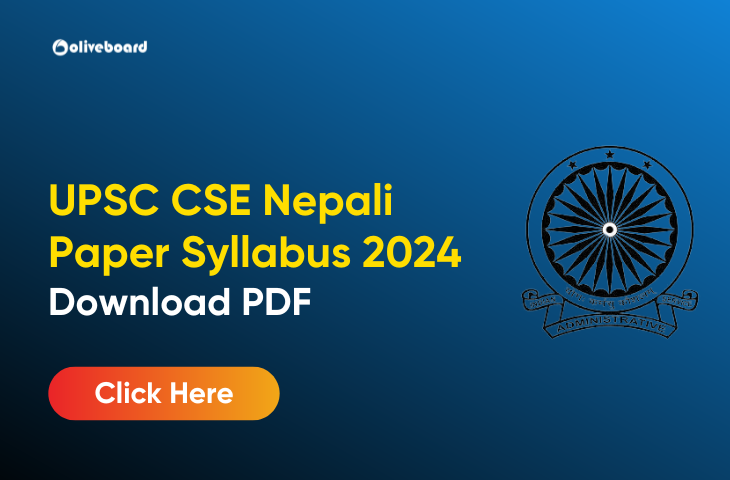UPSC Nepali Syllabus 2024
The UPSC Nepali syllabus for 2024 will evaluate candidates on reading comprehension, précis writing, translation abilities, and knowledge of Nepali grammar and literary concepts. Key areas of focus will include grasping main ideas, summarizing texts concisely, translating accurately between Nepali and English, properly applying grammar rules, and demonstrating understanding of Nepali literary devices, themes, and genres. Regular reading of Nepali newspapers, books, and magazines will build strong comprehension and vocabulary.
You can download the UPSC CSE Nepali Optional language paper syllabus from the direct link given below.
UPSC Nepali Syllabus 2024 Overview
Nepali, an official Indian language, is used in several states across North and Northeast India. The UPSC Nepali literature syllabus evaluates candidates on their comprehension, written expression, translation abilities, grammar knowledge, and understanding of Nepali literary works. Proficiency in reading, writing, and speaking literary Nepali is vital to succeed in this UPSC optional exam.
Nepali Literature Syllabus for UPSC CSE 2024
The UPSC Nepali literature optional covers the language’s history, grammar, folklore, and diverse literary genres including specific Nepali works. The 500 marks exam is split across two papers testing proficiency in reading, writing, speaking literary Nepali, and analyzing Nepali literature. Thorough preparation of the expansive syllabus is key to succeed.
If you opt for Nepali language as optional in UPSC mains, prepare it thoroughly. Go through the UPSC CSE Syllabus and previous years’ Nepali papers. The CSE Mains includes two test papers on the optional subject selected by the candidate, each for 250 marks.
UPSC CSE Nepali Syllabus 2024 for Paper 1
Section A
- History of Nepali Language
- Discuss the origin and development of Nepali as one of the new Indo-Aryan languages, tracing its historical roots and evolution over time.
- Fundamentals of Nepali Grammar and Phonology
- (i) Nominal forms and categories: Gender, Number, Case, Adjectives, Pronouns, Avyayas
- (ii) Verbal forms and categories: Tense, Aspects, Voice, Roots and Fixes
- (iii) Nepali Swara and Vyanjana: Explore the phonological aspects of Nepali, including its vowel and consonant systems.
- Major Dialects of Nepali
- Provide an overview of the major dialects of Nepali, highlighting their regional variations and linguistic characteristics.
- Standardisation and Modernisation of Nepali
- Discuss the efforts in standardising and modernising Nepali, with special reference to language movements like Halanta Bahiskar and Jharrovad, examining their impact on the language’s development.
- Teaching of Nepali Language in India
- Trace the history and development of teaching Nepali language in India, focusing on its socio-cultural aspects and its significance in the Indian educational landscape.
Section B
- History of Nepali Literature in India
- Provide a historical overview of Nepali literature’s development in India, highlighting key milestones and significant contributions.
- Fundamental Concepts and Theories of Literature
- Introduce fundamental literary concepts such as Kavya/Sahitya, Kavya Prayojan, Literary genres, Shabda Shakti, Rasa, Alankara, Tragedy, Comedy, Aesthetics, and Stylistics, explaining their significance in literary analysis.
- Major Literary Trends and Movements
- Explore major literary trends and movements in Nepali literature, including Swachchhandatavad, Yatharthavad, Astitwavad, Ayamik Movement, Contemporary Nepali writings, and Postmodernism, discussing their themes, characteristics, and influential figures.
- Nepali Folklores
- Examine different folk forms in Nepali literature, such as Sawai, Jhyaurey, Selo, Sangini, and Lahari, providing insights into their cultural significance and thematic elements.
UPSC CSE Nepali Syllabus 2024 for Paper 2
This paper will require first hand reading of the texts prescribed below and questions will be designed to test the candidate’s critical acumen.
Section A
- Santa Jnandil Das
- Explore the work “Udaya Lahari” by Santa Jnandil Das, delving into its themes, style, and significance within Nepali literature.
- Lekhnath Poudyal
- Analyze select portions from “Tarun Tapasi” by Lekhnath Poudyal (Vishrams III, V, VI, XII, XV, XVIII), examining their poetic elements, symbolism, and thematic content.
- Agam Singh Giri
- Discuss the poems “Jaleko Pratibimba Royeko Pratidhwani” by Agam Singh Giri, focusing on specific pieces like “Prasawako Chichyahatsanga Byunjheko Ek Raat,” “Chhorolai,” and others, exploring their literary merit and artistic expression.
- Haribhakta Katuwal
- Analyze the poems “Yo Zindagi Khai Ke Zindagi” and others from “Yo Zindagi Khai Ke Zindagi” by Haribhakta Katuwal, examining their philosophical themes, poetic imagery, and social commentary.
- Balkrishna Sama
- Examine the literary work “Prahlad” by Balkrishna Sama, discussing its narrative structure, character development, and thematic depth.
- Manbahadur Mukhia
- Discuss the one-act play “Andhyaroma Banchneharu” and “Suskera” by Manbahadur Mukhia, analyzing their plot, character dynamics, and dramatic elements.
Section B
- Indra Sundas
- Analyze the literary work “Sahara” by Indra Sundas, exploring its themes, character portrayal, and narrative style.
- Lilbahadur Chhetri
- Discuss the literary piece “Brahmaputra ko Chheuchhau” by Lilbahadur Chhetri, examining its portrayal of cultural and geographical aspects.
- Rupnarayan Sinha
- Analyze select stories from “Katha Navaratna” by Rupnarayan Sinha, such as “Biteka Kura,” “Jimmewari Kasko,” and others, discussing their narrative techniques, themes, and social commentary.
- Indrabahadur Rai
- Discuss select stories from “Vipana Katipaya” by Indrabahadur Rai, like “Raatbhari Huri Chalyo,” “Jayamaya Aphumatra Lekhapani Aipugi,” and others, analyzing their narrative structures, character development, and thematic richness.
- Sanu Lama
- Examine stories from “Katha Sampaad” by Sanu Lama, such as “Swasni Manchhey,” “Khani Tarma Ekdin,” and others, discussing their literary style, cultural insights, and narrative impact.
- Laxmi Prasad Laxmi
- Analyze select essays from “Nibandha DevkotaSangraha” by Laxmi Prasad Laxmi, including “Sri Ganeshaya Namha,” “Nepali Sahityako Itihasma Sarvashrestha Purus,” and others, exploring their thematic depth, literary criticism, and socio-cultural reflections.
- Ramkrishna Sharma Das
- Discuss select essays from “Gorkha” by Ramkrishna Sharma Das, such as “Kavi, Samaj Ra Sahitya,” “Sahityama Sapekshata,” and others, examining their insights into literature, society, and cultural progress.
Writing daily in Nepali, practicing translation, and studying grammar and literary concepts will enable aspirants to master the syllabus. Proficiency in reading, writing, and speaking Nepali is essential to succeed in the UPSC 2024 exam. Thorough preparation of the syllabus will equip candidates to effectively tackle the Nepali paper.
| Important Links | Important Links |
| UPSC CSE 2024 Apply Online | UPSC CSE 2024 Notification |
| UPSC CSE Eligibility Criteria | UPSC CSE Syllabus |
| UPSC CSE Exam Pattern | UPSC CSE Selection Process |
UPSC Nepali Syllabus 2024 FAQs
The UPSC Nepali syllabus for 2024 will evaluate candidates on reading comprehension, précis writing, translation abilities, and knowledge of Nepali grammar and literary concepts. Key areas of focus will include grasping main ideas, summarizing texts concisely, translating accurately between Nepali and English, properly applying grammar rules, and demonstrating understanding of Nepali literary devices, themes, and genres. Regular reading of Nepali newspapers, books, and magazines will build strong comprehension and vocabulary.
Get Syllabus PDF here: UPSC CSE Nepali Syllabus
There is 250 marks is for one optional paper.

Hello, I’m Aditi the creative mind behind the words at Oliveboard. As a content writer specializing in state-level exams, my mission is to simplify complex exam information and help aspirants navigate their journey with clarity and confidence.
Having walked the path of an aspirant myself, I bring a unique, relatable perspective to my work. I focus on crafting accessible and accurate content on Exam Notifications, Admit Cards, and Results, ensuring candidates have the right information at the right time.
At Oliveboard, I play a key role in empowering students by breaking down the exam process into understandable and actionable insights. My aim is to make preparation less daunting and more rewarding, one well-informed step at a time.
